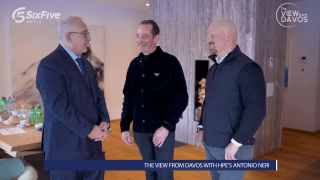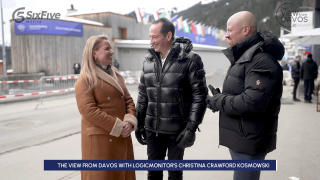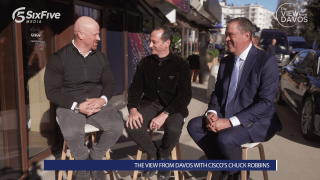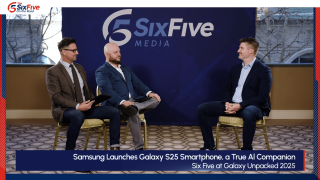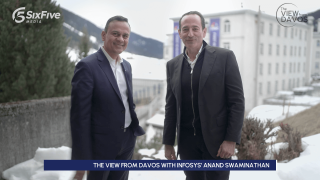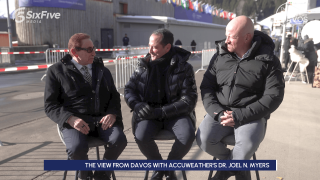Daniel Newman had a fascinating “walk and talk” at Davos with Ericsson’s Head of Enterprise Wireless Solutions, Åsa Tamsons. ❄️ AI & tech innovation demands that we push connectivity to the edge. Get their take on cutting-edge developments in enterprise wireless solutions and the future of connectivity. Tune in as they discuss 👇
- The evolving landscape of enterprise wireless solutions
- The importance of investing in network infrastructure for global competitiveness
- Responsible resource management, even as networks scale to accommodate growing data demands
- The potential of edge computing to power real-time applications like video analytics and AI-driven solutions
- Ericsson’s collaborations with partners to unlock the full potential of edge connectivity
Learn more at Ericsson.
Watch the video below, and be sure to subscribe to our YouTube channel, so you never miss an episode.
Or listen to the audio here:
Disclaimer: The View From Davos is for information and entertainment purposes only. Over the course of this webcast, we may talk about companies that are publicly traded and we may even reference that fact and their equity share price, but please do not take anything that we say as a recommendation about what you should do with your investment dollars. We are not investment advisors, and we ask that you do not treat us as such.
Transcript:
Daniel Newman: Hey, everyone. The Six Five On the Road here with a View from Davos. Actually, I should say The Six Five is on the move, because we’re moving here.
Åsa Tamsons: We’re moving.
Daniel Newman: We’re walking and talking.
Åsa Tamsons: We’re moving.
Daniel Newman: And we’re heading down the promenade. Asa, it’s so good to have you back. Last year, we stood in the snow. It was Six Five in the snow. And we talked a little bit about what was going on in Davos. This year, you and I have had a few chances to get together. You sat on a panel with me at Kearney where we talked about this new CEO research. Thank you so much for that. And then I moderate a panel for you.
Åsa Tamsons: Thank you so much.
Daniel Newman: So now we’re all even. Now I owe you one, because now you’re coming back and helping me. Look, as we walk and talk here down the promenade, one of the things I want to ask executives like you where you’re leading Ericsson is when you come to Davos, what is the big sort of goal? You know, You see some of these firms have big houses. They’re making huge investments. And I think Ericsson has a big presence, big delegates, a number of delegates, but not on the promenade necessarily. What do you come here? What do you hope to achieve in the five days you’re here?
Åsa Tamsons: Well, we’re a relatively small delegation from Ericsson and we have a very small, very thin back office. We’re basically just of us with a clear purpose, our CEO, our CTO, our head of government and political affairs, our head of sustainability, our head of Europe and Latin America, and myself who runs the enterprise wireless solutions business.
Daniel Newman: All right.
Åsa Tamsons: So I think overall, I mean, one is to drive the awareness and influencing understanding of how important investments in the network infrastructure is critical, not only for companies but also for industries and at, you could say, at the core of it, nation’s competitiveness. So that’s one part. Another part, there are a lot of tech firms here, so that prominent folks. So we have a lot of partners that we take the opportunity to meet while we’re here together. On my-
Daniel Newman: Like at Qualcomm last night.
Åsa Tamsons: Like Qualcomm last night.
Daniel Newman: We had a nice evening.
Åsa Tamsons: It’s nice and I think it’s a great opportunity to actually spend some quality one-on-one time while we’re all here. But there also sustainability, I think it’s a topic we have not talked as much this year. But I think the planet hasn’t changed. We still have to move that topic. So we still believe in energy efficiency. We do believe we need to be mindful of our resources, whether that’s energy capacity, if that’s other type of resources. So that’s one. And for me, being a traditional in the heart, we’re a telecom industry and telecom company, here, you have a much broader industry. And for us, networks of the future are here to not only provide our cell phones with connectivity but all important enterprise and industry applications. So personally, I spend a lot of time meeting companies in different sectors to understand, both drive awareness, but also how we can work closely together to connect to factories, to warehouses, to solve problems where they don’t have connectivity at the edge, but also make them aware about what competence, capabilities we have and build relationships.
Daniel Newman: Absolutely. Yeah. No. I mean, great. It was like a chance-and-stance meeting last year and now we’ve been able to build a rapport over a year and spend more time together and learning a lot about what you’re doing. It’s great. You mentioned something that I think has been sidelined and I think with the new administration in the US and knowing the world tends to follow the lead in the US in many things, there’s some things we do that are not always appreciated and I understand that, but like when it comes to technology, it’s really a driving force. We’re seeing regulation change. We’re seeing a bit of a pull away from some of this. Ericsson being a Swedish company and thinking… I’m not trying to get too political, but I just wonder how are you guys thinking about bringing that back into the light? Because at Davos here, it’s been much less of a subject, but to your point, planet’s not changing.
Åsa Tamsons: Yeah. I think for us it’s being… Running technology that actually relies on global standardization. So we work with all our competitors to set the standard for the foundation, our technology, which I think is pretty unique. So we actually can provide a better consistent service around the world. So at the heart of it, we’re a global company.
Daniel Newman: Yeah. Absolutely.
Åsa Tamsons: Sweden’s the whole market is tiny. So for us, being present in the large markets that drive momentum. And obviously US is a big home market for us. India is a growing market for us. And frankly, we have a mission where we really want to power the network and the next wave of growth for industries and the world. So I think for us, that’s our mission and now we have to adapt for how we need to operate.
Daniel Newman: Yeah. And one of the really practical things I would say is the edge provides a really big opportunity to be more thoughtful about where… You and I did a panel together, Where Computation Takes Place. Something else I’d love to talk to you a little bit about is Ericsson’s story. You and I have had the chance, a little bit on the sidelines, but not necessarily on the record, to talk about a company in transition. Still a prominent brand, known around the world, clearly driving the telco, the mobile, the network industry, but also much bigger than that. I mean, when you think of this stuff, it all connects to data centers. It all provides an avenue to running LLMs. How are you describing it for those that maybe didn’t come up in the first large wave of Ericsson’s growth and are now seeing this new sort of version of Ericsson? And by the way, a lot of great history, a lot of great pedigree. I’m not saying it’s not. But I’m kind of… I want to hear more about how it’s evolving.
Åsa Tamsons: Where we pushing now is really how we can drive limitless connectivity to improve people’s lives, redefine businesses and pioneer sustainable future, and at the heart of it, a really programmable open network where you can start access the resources like a network API, just as we have been doing with a lot of other capabilities in the software stack. But many of these capabilities are built down deep in a core network. So here we’ve done an amazing job, I would say, over the last couple of years to make sure we can actually start, build network capabilities that are accessible and also open so developers can access it in a different way than before. The other part is of course we see we play an important role in driving energy efficiency. So how do we continue while we bring more capacity, lower latency, better capabilities, and we actually increased the scaling of our services. How do we do that while becoming 10X for every jump, more energy efficient so we don’t consume more energy just because we’re using more? And I think that’s a question that is not only important for us, but also as we scale gen AI applications. And there I think AI, but also using the right type of connectivity or process the data where it’s really needed or more relevant will be an important topic as we continue to scale automation AI at the edge and at the core.
Daniel Newman: Absolutely. So maybe we can finish up here. You and I sat on a panel together in the bubble, The Dome with MIT, Forbes, and the topic was connectivity at the edge. I’d love to get your take on that particular conversation, that opportunity. We know a lot of what you just said about where computation takes place, but what is the sort of perspective that you and Ericsson have on connectivity at the edge? And what do you see happening in the next few years?
Åsa Tamsons: Look, we think, we always thought, connectivity and distributed connectivity is critical. I think what is interesting now, many best effort application and where it’s not critical get the data back, if you send a message, for instance, maybe it’s okay that it gets processed a minute later or whenever it’s available. I think where we’re quite excited is the possible when you can start to manage voice and video, not only data, but exchange at the edge. So think about many of these gen AI solution right now. We had this company, VoiceBrain. They’re actually powering, empowering, the staff at the front at airports to get real-time information just by analyzing and assessing unstructured voice data real-time. There are a lot of interesting applications. So we see that in law enforcement, fire responders, but also frankly in inventory in hospitals where you now actually start to see the commercialization of video analytics powered by our connectivity. And I think it’s quite… You will not need cellular connectivity everywhere, but you actually now have the possibility to do that but at much competitive cost with the delivery and quality that you need at edge to start actually scaling a lot of exciting applications that bring better safety, improve health, but also improve productivity and energy efficiency. I think that’s exciting. But I think also back to the question or conversation we had in IoT, we’ve been talking about it. I said 20 years, probably 40 years, or something like that, and now we start to see some of the real value that we’ve been talking about actually being enabled.
Daniel Newman: Absolutely. Hey, Asa, I want to thank you so much. It was great spending time with you here in Davos. We’re right… The Magic Mountain is right here behind us. Or is it that one? I don’t know which one it is, but it’s always so wonderful to spend time with you. Congratulations on the success so far and look forward to doing many more things together and having you back on the show with me.
Åsa Tamsons: Wonderful.
Daniel Newman: So have a great rest of your Davos.
Åsa Tamsons: Thank you.
Daniel Newman: And thank you, everybody, for joining this little walk and talk. I’m Daniel Newman. This is The Six Five. We are On the Road or we’re on the street here in Davos. Appreciate you tuning in. We’ll see you all later.


